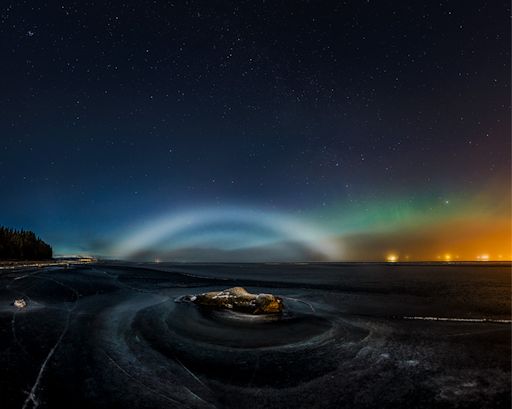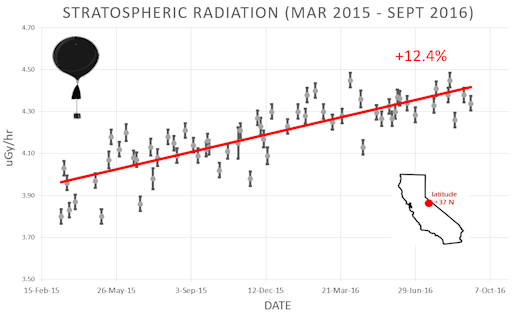Bring in the New Year with Marianne's Arctic Xpress. Spend Christmas or New Year in a remote Norwegian cabin. Chase auroras every night or join a day tour to see fjords, whales, eagles and an abundance of wildlife. Book Now | | | APPROACHING THE SOLAR WIND STREAM: Later today, Dec.20th, Earth is expected to enter a stream of solar wind flowing at high speed from a large hole in the sun's atmosphere. This could set in motion days of magnetic unrest around the poles. NOAA forecasters estimate a 60% chance of minor G1-class geomagnetic storms on Dec. 21st, increasing to 65% on Dec. 22nd. Stay tuned for Arctic auroras. URSID METEOR SHOWER: Earth is passing through a filament of debris from comet 8P/Tuttle, source of the annual Ursid meteor shower. If forecasters are correct, the shower should peak on Dec. 22nd with 5 to 10 meteors per hour flying out of the constellation Ursa Minor (the Little Dipper). Eliot Herman photographed an early-arriving Ursid on Dec. 17th from Tucson, AZ: 
The most intense phase of the Ursid shower is brief, typically just 12 hours or so. The narrow 2016 peak is expected to arrive around 0900 UT (4 a.m. EST/ 1 a.m. PST) on Thursday morning--good timing for North America. Note: This is considered to be a minor shower. Nevertheless, outbursts of Ursids occasionally surprise observers with rates many times normal. Monitor the realtime meteor gallery for sightings. Realtime Meteor Photo Gallery ARCTIC LIGHT SHOW: What do you get when you mix moonlight, fog, and solar wind near the Arctic Circle? Photographer Göran Strand of Östersund, Sweden, provides the answer: "A lunar fogbow backlit by Northern Lights." 
Strand took this picture on Dec.17th from the shore of Lake Storsjön, the 5th largest body of water in Sweden. A layer of fog hovering above the lake's surface intercepted rays of moonlight to form a lovely fogbow. "Fogbows have been on my bucket list for quite some time," says Strand. "I've seen photos of them, but I've never seen one in real life until now." Fogbows are close cousins of rainbows and they are formed in essentially the same way: light bounces in and out of water droplets to produce a luminous arc. The background glow of green auroras was caused by a minor stream of solar wind, which buffeted Earth's magnetic field over the weekend. Realtime Aurora Photo Gallery ORDER TODAY FOR CHRISTMAS DELIVERY: To raise money for their space weather ballooning program, the students of Earth to Sky Calculus have flown 10 "Tree of Life" pendants to the edge of space. You can have one for $79.95. The limited edition pendant comes with a greeting card showing the jewelry in flight and certifying that it has been to the stratosphere and back again. 
The pendants flew to the edge of space on Nov. 20, 2016, alongside an array of cosmic radiation sensors. During the flight, the sensors picked up the highest levels of radiation recorded so far during our 2 year monitoring program. After the balloon exploded, the payload parachuted back to Earth, landing in the snowy San Antonio mountains north of Tonopah, Nevada, where a student team recovered it on Nov. 22nd. The research of Earth to Sky Calculus is not supported by government grants or corporate donations. Instead, we are entirely crowd-funded. Proceeds from the sale of items like the Space Pendant go right back into cutting-edge student research. More far out Christmas gifts may be found in the Earth to Sky Store. Realtime Space Weather Photo Gallery
Realtime Airglow Photo Gallery
Realtime Sprite Photo Gallery Every night, a network of NASA all-sky cameras scans the skies above the United States for meteoritic fireballs. Automated software maintained by NASA's Meteoroid Environment Office calculates their orbits, velocity, penetration depth in Earth's atmosphere and many other characteristics. Daily results are presented here on Spaceweather.com. On Dec. 20, 2016, the network reported 28 fireballs.
(25 sporadics, 1 Comae Berenicid, 1 December Leonis Minorid, 1 alpha Hydrid)  In this diagram of the inner solar system, all of the fireball orbits intersect at a single point--Earth. The orbits are color-coded by velocity, from slow (red) to fast (blue). [Larger image] [movies] Potentially Hazardous Asteroids ( PHAs) are space rocks larger than approximately 100m that can come closer to Earth than 0.05 AU. None of the known PHAs is on a collision course with our planet, although astronomers are finding new ones all the time. On December 20, 2016 there were potentially hazardous asteroids. Notes: LD means "Lunar Distance." 1 LD = 384,401 km, the distance between Earth and the Moon. 1 LD also equals 0.00256 AU. MAG is the visual magnitude of the asteroid on the date of closest approach. | | Cosmic Rays in the Atmosphere |
Readers, thank you for your patience while we continue to develop this new section of Spaceweather.com. We've been working to streamline our data reduction, allowing us to post results from balloon flights much more rapidly, and we have developed a new data product, shown here: 
This plot displays radiation measurements not only in the stratosphere, but also at aviation altitudes. Dose rates are expessed as multiples of sea level. For instance, we see that boarding a plane that flies at 25,000 feet exposes passengers to dose rates ~10x higher than sea level. At 40,000 feet, the multiplier is closer to 50x. These measurements are made by our usual cosmic ray payload as it passes through aviation altitudes en route to the stratosphere over California. What is this all about? Approximately once a week, Spaceweather.com and the students of Earth to Sky Calculus fly space weather balloons to the stratosphere over California. These balloons are equipped with radiation sensors that detect cosmic rays, a surprisingly "down to Earth" form of space weather. Cosmic rays can seed clouds, trigger lightning, and penetrate commercial airplanes. Furthermore, there are studies ( #1, #2, #3, #4) linking cosmic rays with cardiac arrhythmias and sudden cardiac death in the general population. Our latest measurements show that cosmic rays are intensifying, with an increase of more than 12% since 2015: 
Why are cosmic rays intensifying? The main reason is the sun. Solar storm clouds such as coronal mass ejections (CMEs) sweep aside cosmic rays when they pass by Earth. During Solar Maximum, CMEs are abundant and cosmic rays are held at bay. Now, however, the solar cycle is swinging toward Solar Minimum, allowing cosmic rays to return. Another reason could be the weakening of Earth's magnetic field, which helps protect us from deep-space radiation. The radiation sensors onboard our helium balloons detect X-rays and gamma-rays in the energy range 10 keV to 20 MeV. These energies span the range of medical X-ray machines and airport security scanners. The data points in the graph above correspond to the peak of the Reneger-Pfotzer maximum, which lies about 67,000 feet above central California. When cosmic rays crash into Earth's atmosphere, they produce a spray of secondary particles that is most intense at the entrance to the stratosphere. Physicists Eric Reneger and Georg Pfotzer discovered the maximum using balloons in the 1930s and it is what we are measuring today. | | The official U.S. government space weather bureau | | | The first place to look for information about sundogs, pillars, rainbows and related phenomena. | | | Researchers call it a "Hubble for the sun." SDO is the most advanced solar observatory ever. | | | 3D views of the sun from NASA's Solar and Terrestrial Relations Observatory | | | Realtime and archival images of the Sun from SOHO. | | | from the NOAA Space Environment Center | | | a proud supporter of science education and Spaceweather.com | | | the underlying science of space weather |  | Beautyz for top beauty products reviews and their buying guides | | | These links help Spaceweather.com stay online. Thank you to our supporters! | | 
